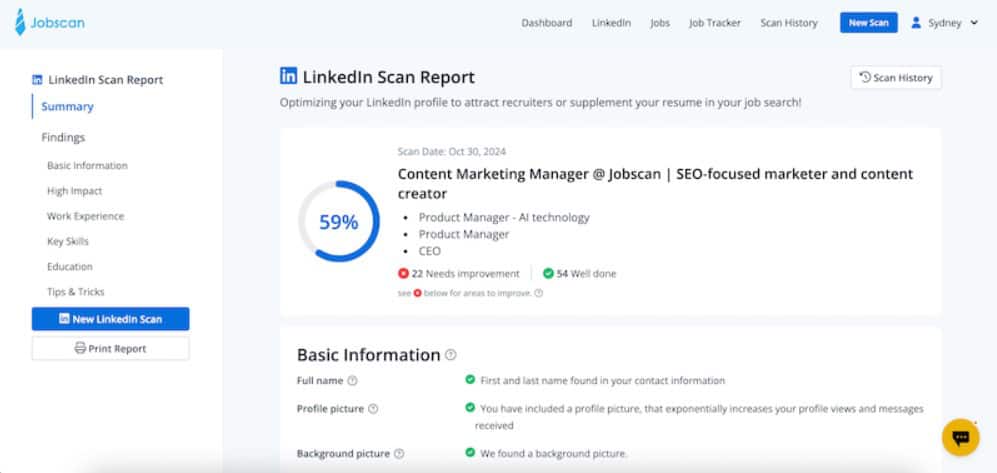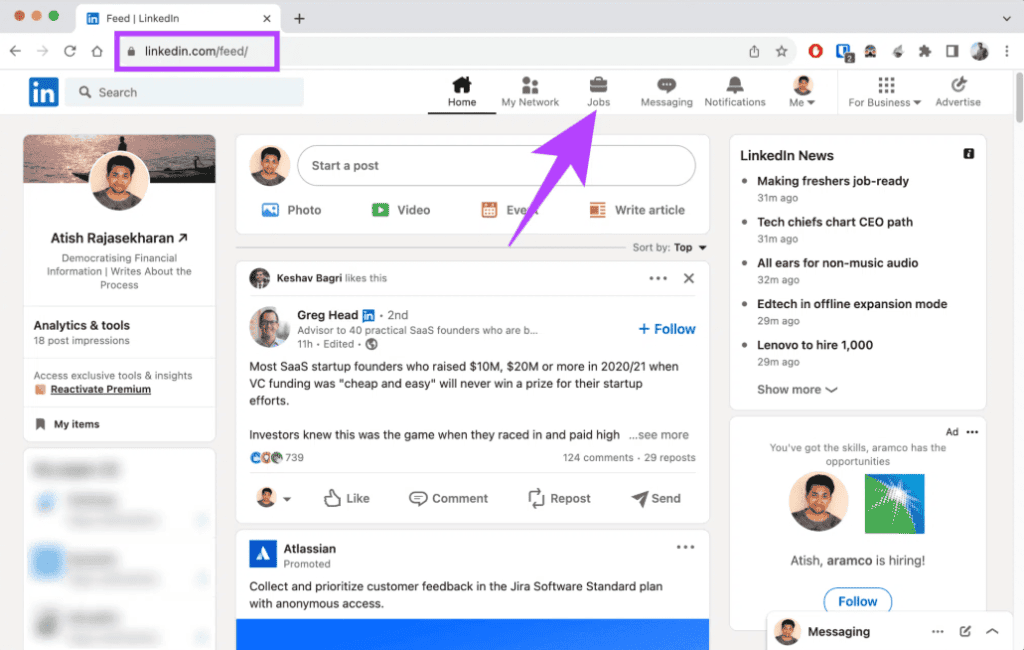Stepping into the U.S. job market as a recent graduate or student is a critical phase of your career journey.
You know online job boards are essential, but one platform stands out as uniquely powerful: LinkedIn.
It’s more than just a job board; it’s the world’s largest professional network.
However, simply having a profile isn’t enough. The key lies in understanding how to search for jobs on LinkedIn effectively, leveraging its full potential to discover, connect with, and impress employers for your first professional role in the United States.
This guide will take you beyond basic searches, providing actionable strategies to optimize your profile, master LinkedIn’s features, and tap into the hidden job market for entry-level success.
1. Why LinkedIn is Your Job Search Powerhouse (Beyond Just Jobs)
For recent graduates, LinkedIn offers unparalleled advantages that traditional job boards simply cannot match.
It’s a multi-faceted tool crucial for every stage of your job search.
Beyond Basic Job Listings:
- Professional Networking: LinkedIn is built for connections. You can find and connect with alumni, industry professionals, and recruiters, opening doors to unadvertised opportunities.
- Company Research: Dive deep into company pages to understand their culture, values, recent projects, and employee demographics. This insight is invaluable for tailoring your applications.
- Personal Branding: Your LinkedIn profile acts as your online professional resume, showcasing your skills, achievements, and thought leadership. Recruiters actively search for candidates here.
- Industry Insights: Follow industry leaders and companies to stay updated on trends, news, and discussions, helping you speak confidently during interviews.
- Direct Access to Recruiters: Many recruiters use LinkedIn to source candidates directly. A strong, optimized profile makes you discoverable.
- Alumni Network: A powerful feature allowing you to see where graduates from your university work, making it easier to find contacts for informational interviews.
Insight: While other platforms help you find jobs, LinkedIn helps you get found and build relationships that often lead to jobs.
Data from LinkedIn itself consistently shows that candidates referred by an employee have a significantly higher chance of being hired.
2. Optimizing Your LinkedIn Profile for Job Search Success
Before you even begin searching, your LinkedIn profile needs to be a magnet for recruiters.
Think of it as your dynamic, online resume—your initial impression.
Key Profile Optimization Steps:
- Professional Photo: Use a clear, professional headshot.
- Compelling Headline: Beyond your current student/graduate status, use keywords relevant to your target roles (e.g., “Recent Marketing Graduate | Aspiring Digital Marketer | Social Media & Analytics Enthusiast”).
- Impactful “About” Section (Summary): This is your elevator pitch. Use keywords, highlight your key skills, academic achievements, and career aspirations (2-3 paragraphs). Make it easy to read.
- Detailed Experience:
- Academic Projects: Treat major academic projects (capstones, research papers, group assignments) like mini-jobs. Detail your role, responsibilities, tools used, and quantifiable outcomes.
- Internships/Volunteer Work: List these with strong action verbs and metrics, just like paid experience.
- Part-Time Jobs/Extracurriculars: Focus on transferable skills gained (e.g., customer service, teamwork, leadership, organization).
- Robust “Skills” Section: Add at least 5-10 relevant skills. LinkedIn allows you to get endorsements for these, adding credibility. Populate with keywords from job descriptions.
- Education: Detail your university, degree, major, graduation date, relevant coursework, and academic honors.
- Licenses & Certifications: Include any professional certifications (e.g., Google Analytics, HubSpot, industry-specific certs).
- Recommendations: Request recommendations from professors, internship supervisors, or mentors who can vouch for your abilities.

Actionable Tip: Regularly update your profile.
Use LinkedIn’s “Career Interests” section to signal your openness to new opportunities and desired roles/industries to recruiters.
Ensure your profile is “All-Star” status for maximum visibility.
3. Mastering LinkedIn’s Job Search Features
LinkedIn’s job board is incredibly powerful, offering granular search and filtering options that can dramatically streamline your hunt for entry-level roles.
Effective Job Search Strategies:
- Utilize the “Jobs” Tab: This is your starting point.
- Keywords: Use specific job titles (e.g., “Marketing Assistant,” “Junior Software Engineer”) combined with keywords like “entry-level,” “new grad,” “associate.”
- Location Filters: Specify your target cities/states.
- Experience Level Filter: Always select “Entry-level” or “Internship.”
- Date Posted: Filter by “Past 24 hours” or “Past Week” to see fresh opportunities.
- “Easy Apply” Filter: While convenient, remember to still tailor your resume and cover letter for these.
- Company Filters: Search for jobs within specific companies you’re interested in.

- “Skills” Tab: After a job search, LinkedIn shows a “Skills” tab where you can see which skills are most common among successful applicants for similar roles. Use this to refine your profile.
- “Under 10 Applicants” Filter: This is a hidden gem. It helps you find jobs with less competition, increasing your chances.
- Saved Searches & Job Alerts: Set up email or in-app notifications for your most common search queries. This ensures you never miss a new posting.
- Career Interests: Fill out the “Career Interests” section in your profile to allow LinkedIn’s algorithm to recommend jobs automatically and signal your availability to recruiters.
Insight: Tailoring your resume for each application remains paramount, even when using “Easy Apply.” Understanding how Applicant Tracking Systems (ATS) work is critical for passing initial screens.
For more detailed guidance on What Does It Mean When Application Is Under Review? after submission, ensure your resume is ATS-friendly.
For a concise yet powerful tip on how to optimize your job search directly on LinkedIn, watch this video:
4. Leveraging LinkedIn for Networking & The Hidden Job Market
Many jobs are filled through referrals and connections, sometimes before they’re ever publicly advertised.
LinkedIn is your primary tool for accessing this “hidden job market.”
Strategic Networking Approaches:
- Connect with Alumni: Use the “Alumni” tool on your university’s LinkedIn page. Filter by industry, company, or location to find graduates in roles you admire. Send personalized connection requests and politely ask for informational interviews (brief chats to learn about their career path, not to ask for a job directly).
- Find Recruiters & Hiring Managers:
- Search for “Recruiter” or “Talent Acquisition” at your target companies.
- For specific roles, search for the job title at the company (e.g., “Marketing Manager at [Company Name]”) and see who holds similar positions—they might be the hiring manager.
- Send a personalized connection request, mentioning why you want to connect (e.g., “Saw your work at X, interested in connecting as I explore Y opportunities”).

- Searching Newsfeed Posts: Actively browse your LinkedIn newsfeed or use the search bar to look for posts about job openings. Recruiters and companies often share new opportunities directly in their feeds, sometimes before they hit the official job board. Use filters like “Date posted” to find fresh posts.

- Engage with Content: Like, comment on, and share posts from companies and professionals in your target industry. This increases your visibility and demonstrates your engagement.
- Follow Companies: Follow your target companies to stay updated on their news, culture, and job postings. This also signals your interest to them.
- Join Groups: Participate in relevant industry or professional groups. This is a great way to learn, ask questions, and connect with peers and potential employers.
Insight: Referrals significantly boost your chances.
LinkedIn’s data shows that candidates who apply for jobs through employee referrals have a significantly higher chance of being hired.
This often bypasses initial screening. For more general insights on finding opportunities, explore our guide on How to Find a Job Fast with No Experience.
5. Advanced LinkedIn Strategies for New Grads
Go beyond the basics to truly stand out and make LinkedIn work harder for your entry-level job search.
Beyond Basic Searches:
- Boolean Search: Use advanced search operators (AND, OR, NOT, parentheses, quotation marks) within the LinkedIn job search bar to refine your results.
- Example:
(Marketing OR "Digital Marketing") AND "Entry Level"
- Example:
- “People” Search to Find Job Leads: Sometimes jobs aren’t posted. Find people in roles you want at target companies, then reach out for informational interviews. Their insights might reveal unadvertised opportunities.
- LinkedIn Learning: Utilize LinkedIn Learning for courses that build in-demand skills relevant to your target jobs. Showcase completed courses and certifications on your profile.
Proactive Engagement & Ethical Conduct:
- Customized Connection Requests: When sending connection requests, always add a personalized note explaining why you want to connect. Avoid generic requests.
- Informational Interview Etiquette: If someone accepts an informational interview, be prepared with thoughtful questions. Never ask for a job directly. Focus on learning.
- Professionalism: Maintain a professional demeanor in all interactions. Your online presence is a reflection of your professional brand.
Insight: While LinkedIn is a powerful tool, it’s essential to use it ethically and professionally.
Remember that recruiters can see your activity, so ensure your interactions align with your job search goals.
For a deeper dive into application methods, consider our guide on Is It Better to Apply Online or In Person?.
Final Checklist: Your LinkedIn Job Search Power-Up
Before confidently navigating LinkedIn for your job search, run through this quick checklist:
- Profile Optimized: Professional photo, compelling headline, detailed “About” section, relevant experience/projects, strong skills section with keywords.
- Career Interests Set: Signaled your open-to-work status and desired roles/industries.
- Search Skills Mastered: Using keywords, filters (entry-level, date posted, under 10 applicants), and saved searches.
- Networking Strategy: Actively connecting with alumni, recruiters, and industry professionals; sending personalized messages.
- Engagement: Following companies and engaging with relevant content.
- Professionalism: All interactions are polite, concise, and value-driven.
- Resume Ready: Your actual resume is updated and tailored for each application. For insights on applying for roles where you might not meet every single criterion, see our guide on Should I Apply to Jobs I’m Not Qualified For?.
Actionable Tip: Dedicate consistent time to your LinkedIn job search. It’s a continuous process that yields results through persistence and smart engagement.
For maximizing your application efforts, understand When Is The Best Time To Apply For Jobs? to combine strategic timing with your LinkedIn activity.
Conclusion: LinkedIn, Your Launchpad for US Entry-Level Success
Mastering how to search for jobs on LinkedIn is indispensable for recent graduates entering the U.S. job market.
It’s more than just a platform for job postings; it’s a dynamic ecosystem where you can build your professional brand, research target companies, strategically network, and uncover opportunities often hidden from public view.
By meticulously optimizing your profile, leveraging advanced search features, and engaging proactively with the professional community, you transform LinkedIn into your most powerful job search tool.
Your ability to connect, showcase your unique value, and demonstrate genuine interest will set you apart from the competition.
Arm yourself with these strategies, commit to a disciplined LinkedIn presence, and confidently launch your career.
Your first professional success in the United States is within reach.
F.A.Q
Q1: Is a LinkedIn profile just an online resume, or is it more?
A1: Your LinkedIn profile is much more than just an online resume. While it showcases your experience and skills, it’s primarily a professional networking platform. It allows you to build your personal brand, connect with recruiters and industry professionals, research companies, gain industry insights, and tap into the “hidden job market” through referrals and connections.
Q2: How can I make my LinkedIn profile stand out if I have no work experience?
A2: If you have no formal work experience, focus on optimizing every section of your profile. Use a professional photo and a compelling headline with relevant keywords. Detail academic projects, internships, volunteer work, and extracurriculars, highlighting transferable skills and quantifiable achievements. Include a robust “About” section and list relevant skills, seeking endorsements.
Q3: Should I connect with recruiters even if I’m not actively looking for a job right now?
A3: Yes, it’s highly recommended to connect with recruiters and other professionals even if you’re not actively job searching. Building your network proactively means you’ll have connections established when you do need them. Send a personalized connection request explaining why you’d like to connect (e.g., “Interested in [Industry/Field] and admire your work at [Company]”).
Q4: Is it better to apply for jobs directly on LinkedIn (“Easy Apply”) or on the company’s website?
A4: While LinkedIn’s “Easy Apply” is convenient, it’s often best to prioritize applying directly on the company’s career page if available. Direct applications can sometimes receive more attention. However, “Easy Apply” is good for quick submissions. For optimal results, you can apply directly and then follow up with a recruiter on LinkedIn.
I specialize in managing and auditing end-to-end HR functions, ensuring full compliance with state and federal regulations. I partner with leadership to drive strategic HR initiatives and implement necessary changes. My core strength lies in identifying, hiring, and training top talent to enhance team performance and support organizational growth.






